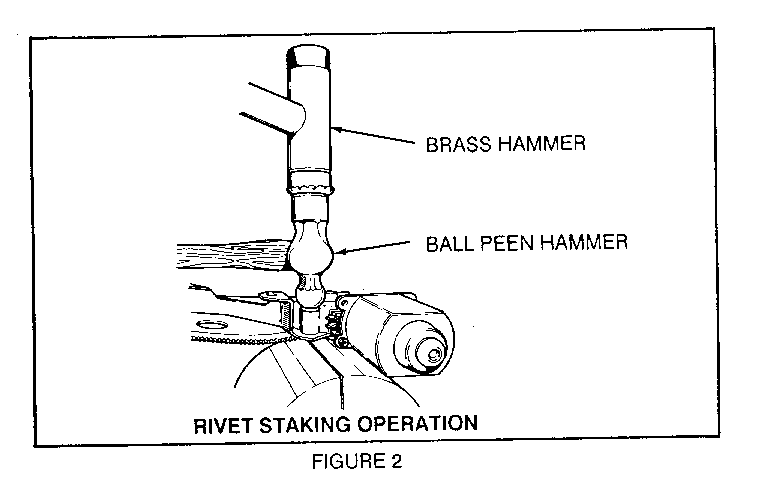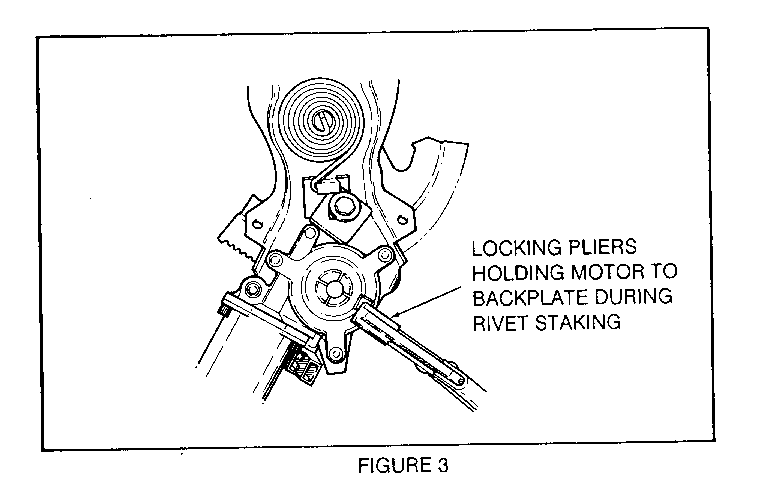SER.MAN.UPDATE FRT.DOOR REG. REVISED SERVICE PROCEDURE

SUBJECT: SERVICE MANUAL UPDATE - FRONT DOOR WINDOW REGULATOR MOTORS, REVISED SERVICE PROCEDURE
MODELS/YEARS: 1988-91 CUTLASS SUPREME
This bulletin cancels and supercedes Dealer Technical Bulletin 89-T-23. Please discard Dealer Technical Bulletin 89-T-23.
This bulletin describes a revised procedure to replace electric window lift motors from front window regulator mechanisms in 1988-91 Cutlass Supreme models. Please mark a reference to this bulletin in the following Cutlass Supreme Service Manuals:
YEAR PAGE
1988 10-5W-17 1989 10-5-16 1990 10-5-33 1991 10-6-41
1. Remove regulator assembly from door.
CAUTION:
STEP 2 MUST BE PERFORMED WHEN REGULATOR IS REMOVED FROM DOOR. THE REGULATOR LIFT ARM IS UNDER TENSION FROM THE COUNTERBALANCE SPRING AND CAN CAUSE PERSONAL INJURY IF THE MOTOR IS REMOVED WITHOUT LOCKING THE SECTOR GEAR IN POSITION.
2. Drill a hole through the regulator sector gear and backplate (See Figure 1) and install a bolt and nut to lock sector gear in position. Do not drill hole closer than 13 mm (112") to edge of sector gear or backplate.
3. Using a 1/4" drill bit, drill out the ends of all 3 motor to regulator attaching rivets from the motor side of the assembly (See Figure 1).
4. Remove the motor from the regulator and the remaining portions of the rivets.
5. Position new motor to the regulator backplate and with the aid of a helper, install motor with 1 rivet (bottom location, Figure 1) by collapsing or crushing end of rivet (P/N 9441949) with a ball peen type hammer as shown in Figure 2. Parts are currently available from GMSPO.
6. Once the motor is installed with 1 rivet, clamp the motor to the backplate with locking pliers as shown in Figure 3.
7. Remove bolt securing sector gear to backplate and using an electric power source, move regulator in one direction to gain access to 2nd rivet.
8. Remove old rivet head and install new rivet (P/N 9441949) using the procedure in step 5 (See Figure 2).
9. Using same power source, move regulator in opposite direction and repeat step 8.
10. Remove locking pliers and reinstall regulator assembly into door using 1/4" x 112" peel type rivets.



General Motors bulletins are intended for use by professional technicians, not a "do-it-yourselfer". They are written to inform those technicians of conditions that may occur on some vehicles, or to provide information that could assist in the proper service of a vehicle. Properly trained technicians have the equipment, tools, safety instructions and know-how to do a job properly and safely. If a condition is described, do not assume that the bulletin applies to your vehicle, or that your vehicle will have that condition. See a General Motors dealer servicing your brand of General Motors vehicle for information on whether your vehicle may benefit from the information.
